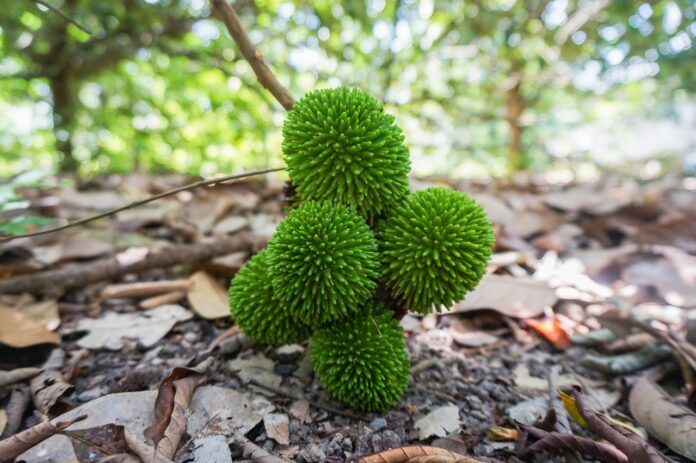Pulasan (Nephelium mutabile) is a tropical fruit related to the rambutan and lychee, native to Southeast Asia, particularly Malaysia and Indonesia. The fruit is known for its vibrant appearance, with a thick, spiny, or bumpy skin that turns red or deep purple when ripe. The spines on the skin are generally shorter and less dense than those of the rambutan.
Interesting Facts About Pulasan:
- Close Cousin to Rambutan: The pulasan fruit is a close relative of the rambutan and lychee, sharing a similar outer appearance and flavor profile. However, pulasan stands out for its softer, jelly-like flesh, which is sweeter and more aromatic than rambutan. The fruit’s flavor is often described as a more pronounced, syrupy sweetness, making it a favorite for those with a sweet tooth
- Twist to Open: The word “pulasan” is derived from the Malay word “pulas,” meaning “to twist.” This name comes from the method used to open the fruit. Instead of using a knife or fingernails to peel the skin, as with rambutan, you twist the pulasan’s outer layer to reveal the juicy interior
- Pulasan trees can grow up to 36 meters tall in their natural rainforest habitats, are primarily cultivated in tropical climates like Malaysia and Indonesia. They are generally grown in well-drained soil and require careful propagation methods, such as grafting, air-layering, and seedlings, to ensure healthy growth and high-quality fruit production
- Unique Flavor: Pulasan’s flavor is often likened to a combination of rambutan and lychee but with an intensified sweetness and juiciness. It has subtle floral and fruity notes, making it perfect for those who enjoy tropical flavors. The fruit’s taste can also vary slightly depending on the ripeness and variety
- Seasonal Availability: Pulasan is a highly seasonal fruit, and its availability is limited to the harvest period, which usually coincides with the rambutan season. This makes it a prized delicacy during its short window of availability, often causing excitement among fruit enthusiasts in Southeast Asia
- Rarely Commercialized: While rambutan and lychee are more commonly exported, pulasan remains relatively unknown in the global market. Its cultivation is often limited to local farmers, and the fruit is sold in regional markets, where it is quickly bought up by locals and visitors
- Native Origins: Pulasan is indigenous to Malaysia and Indonesia but is also found growing in neighboring countries like Thailand and the Philippines. It thrives in tropical climates with high humidity and well-drained soils, making it well-suited to Southeast Asia’s environment
- Cultivation Challenges: Growing pulasan trees can be challenging. They require specific conditions to thrive, such as consistent tropical heat, ample water, and fertile soil. Additionally, the trees are susceptible to certain pests and diseases, which may further limit large-scale farming
- Popular in Rural Areas: In Malaysia, the pulasan is especially popular in rural areas, where it is commonly grown in home gardens or small orchards. The fruit is cherished by local communities, and its arrival in markets often marks a seasonal celebration
- Uncommon Export: Due to its delicate nature and relatively short shelf life, pulasan is not commonly exported. Most of the fruit is consumed locally, making it a rare find for international tourists and fruit enthusiasts outside of Southeast Asia
- High Demand During Season: Despite its limited reach, the demand for pulasan skyrockets during the fruiting season. Local markets in Malaysia and Indonesia experience a surge of buyers eager to get their hands on this delicious treat
- Local Delicacies: Pulasan can be eaten fresh or used in various local delicacies, such as fruit salads, desserts, and beverages. In some Southeast Asian dishes, the fruit adds a refreshing sweetness that complements savory flavors
- Growing Popularity Among Tourists: As more tourists visit Southeast Asia, pulasan has been gaining attention for its unique appearance and delicious taste. It is increasingly becoming a sought-after fruit among travelers looking to explore local food culture
- Environmental Benefits: Pulasan trees are valuable in tropical ecosystems, providing shade and contributing to biodiversity. They support wildlife by offering habitat and food, and the trees can even improve soil quality in orchards
- Family Tree: Pulasan belongs to the Sapindaceae family, which includes other tropical favorites like lychee and longan. This botanical family is known for fruits with juicy flesh and large, inedible seeds, popular for their sweetness
- Artisan Products: The wood of the pulasan tree is sometimes used by artisans to craft small items or traditional instruments. Its hardwood is durable and has cultural significance in some local communities
- Still a Mystery: While there is growing interest in pulasan, it remains relatively under-researched compared to its more famous relatives. Scientists are still investigating its potential health benefits, nutritional composition, and agricultural potential
